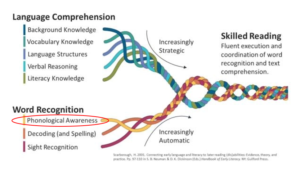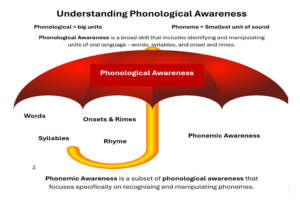Phonological Awareness, Phonemic Awareness and Phonics.

Scarborough’s Reading Rope
“Capacity for reading comprehension is determined by ability to decode text and ability to comprehend spoken language.” (Phil Gough)
Word recognition is the foundation of reading; all other processes are dependent on it (Snowling & Hulme, 2011).
*Please note that when I am referring to a spoken sound (phoneme) I will use / / to differentiate between phoneme and grapheme. For example, /b/ represents the speech sound (phoneme) produced. When referring to the grapheme used to represent the speech sound it will look like this b.
Print Concepts & Awareness
Print concepts begin as the earliest introduction to literacy. Children who have an awareness of print understand that squiggles on a page represent spoken language. They understand that when a book is read to them, that what is said is linked to the squiggles on the page rather than to the pictures.
Children with print awareness understand that print is used for varying reasons, and its function depends upon the context in which it appears, e.g. restaurant signs & menus, traffic signs, text messages, books can tell a story or gives you information. They see print everywhere in their environment and know that it carries meaning.
In their formative years, children develop an understanding that print is organized in a particular way. That words are made up of letters and that spaces appear between each word, that we read from top to bottom, left to right. Print concepts also include letter knowledge, knowing the names of letters and the sounds they represent. It is the knowledge of the sounds in language that informs the reading process and is the foundation of learning to decode and encode words.
Whilst children are developing their knowledge of print, they continue to develop their phonological knowledge through language exposure. Educators need to have a comprehensive understanding of the phonological and orthographic skills that are essential for children to be able to lift the words from the page, so that they can attend to making meaning.
Watch the following Reading Rockets video, Becoming Aware of Print.
Reading Rockets Print Awareness: Introduction | Reading Rocket

Phonological awareness and phonemic awareness: What’s the difference?
In the paper, ‘Research into practice – phonological awareness’ by Dr. Deslea Konza. Phonological awareness is defined as “a broad term that refers to the ability to focus on the sounds of speech as opposed to its meaning, and it has a number of different levels or components”.
Phonological awareness is a critical skill for all students’ literacy development and a strong predictor of later reading and spelling success (Kilpatrick, 2019). Phonological awareness refers to oral language and is the understanding of the different ways that language can be broken down into smaller parts of sound and manipulated. If we were to consider phonological awareness as an umbrella term, underneath the umbrella sits its subskills:
- word awareness,
- syllable awareness,
- onset/rime awareness,
- rhyme awareness,
- and finally, the most advanced skill, and last to develop is called phonemic awareness.
Learning to read requires children to have an awareness of the sound structure of spoken language and how these patterns of sound can be manipulated. Phonological awareness is the first building block in learning to read.
One of the robust findings of reading research is that proficient reading is strongly associated with the ability to identify, remember and sequence phonemes. The National Reading Panel (NRP) has found over 50 studies verifying that explicitly teaching phonemes was one critical component of reading and spelling instruction (NRP, 2000).
Due to phonological awareness relating only to speech sounds, it is therefore not necessary for students to have alphabetic knowledge in order to develop a basic phonological awareness of language. Students that have a limited understanding of English or language conventions can still start to play with the sounds of the language.
When exploring the phonological space, language learners are hearing words and responding out loud, ensuring also the development of their phonological memory, another essential skill. Phonological awareness is a cognitive skill that can be done with your eyes closed.
If a child is phonologically aware, they have the ability to recognize and manipulate the spoken parts of sentences and words. They are able to:
- identify and create words that rhyme, e.g. a word that rhymes with cat is bat,
- recognizing alliteration, e.g. identify words that begin with the same sound like ‘money’ and ‘m’
- segmenting a sentence into words, e.g. The dog and cat are playing = 6 words
- identify, blend and segment parts in a compound word, e.g. bath / room = bathroom
- identify, blend and segment the syllables in a word, e.g. the word monkey, the syllables are mon /key,
- and blend and segment onset-rimes, e.g. such as in the word dog, the onset (first sound) is d, and the rime is og.
Phonemic awareness (PA) is the ability to identify, isolate, think about, and manipulate the individual sounds (phonemes) in spoken words e.g. in the word shark, there are 3 phonemes, /sh/ /ar/ / k/.
Children learn to play with the sounds of spoken language. This includes:
- blending phonemes into words, e.g. /c/ /a/ /t/ = cat
- segmenting words into phonemes, e.g. dog = /d/ /o/ /g/, shark = /sh/ /ar/ /k/ (3 phonemes)
- deleting phonemes from words, e.g. Take /c/ from cage… What’s left? age
- adding phonemes to words, e.g. Say air, add /ch/ to the front…. The new word is? chair
- and substituting phonemes in words to create new words, e.g. Say beat…change the /b/ to /ch/ …the new word is?
Listen to the following clip from Reading Rockets where reading expert Margie Gillis breaks down phonological awareness.
